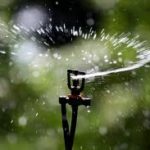Tips for getting the most out of watering your yard.
Watering your lawn and yard doesn’t have to be as expensive as you think during the hot days of summer. Check out The Lawhead Team’s tips for watering your yard during the dog day’s of summer.
During prolonged, dry conditions garden plants, trees, shrubs and lawns may suffer temporary or permanent damage. Lack of water can lead to stunted growth, increased disease/insect susceptibility and increased susceptibility to winter injury. Plants may eventually die unless supplemental water is provided.
Plants draw moisture from the soil to grow and then release water from stems and leaves via transpiration. Plants begin to wilt and suffer when the transpiration rate exceeds water uptake. Water is also lost by evaporation from the soil surface.
The general rule of thumb is that most plants in our area need 1 inch of water per week. If the weather does not cooperate, gardeners need to supplement by watering. Water plants slowly and deeply at least once each week during very hot, dry weather. This allows water to penetrate deeper which encourages deeper roots making plants more resistant to drought. Lawns and bedding plants (annuals) should be watered to at least 6 inches deep. Perennials, shrubs and trees should be watered to at least 12 inches deep. Try watering in the early morning so less water is lost to evaporation. Overhead sprinklers may lose over half the water to evaporation, so use manual watering, soaker hoses or drip irrigation when possible.
If water is restricted or in short supply you need to prioritize which plants get watered. Determine which plants are most susceptible to water stress. High on your watering list should be plants that are valuable in terms of replacement cost or prominence in the landscape. Newly planted trees, shrubs and perennials; newly seeded lawns; plants on sandy soils or in windy sites and vegetables should be given high priority.
After the first month, newly planted trees need a weekly soaking of approximately 10 gallons of water. Smaller trees and shrubs may require less water, but the entire root ball should be thoroughly moistened. If dry weather continues, keep watering newly planted deciduous trees and shrubs until fall (leaf drop). Continue watering evergreens until the soil freezes.
Even established trees and shrubs will benefit from watering during periods of drought. They can go two to three weeks between watering. Established trees should not be watered at the base of the trunk but at the drip line where their absorbing roots are. Thoroughly moisten the soil to a depth of 12 inches out to and beyond the drip line if possible.
When growing vegetables, adequate water during the growing season is directly related to quality and yields. Depending on the species, vegetables have critical times when they really need water. Brussels sprouts, broccoli, cabbage, kohlrabi and cauliflower need consistent moisture during their entire life span, especially during head or root development. Beans use a lot of water; up to a half inch of water per day, especially when they are blooming and setting fruit. Leaves may look grayish if water stressed. Corn needs water most during tasseling, silking and ear development. Tomatoes, peppers and eggplant need water most during flowering and fruiting, however water fluctuations can cause blossom end rot (black area on fruit bottom).
Control weeds around shrubs, vegetables and flowers. Weeds will rob your garden plants of water and nutrients. However, if you hoe or cultivate your garden to control the weeds, continually disturbing the soil can make it dry out faster. Rather than rototilling you may have to cut weeds off at the soil surface or use herbicides until the dry weather subsides.
The best way to protect ornamental plants during dry periods is by using mulch. Mulching minimizes evaporation of water from the soil surface, reducing irrigation needs by about 50 percent. Use organic mulches to a depth of 1 to 3 inches. Keep mulch away from tree trunks and off the top of perennials. Vegetable gardens can also benefit from mulch.
 Avoid pruning when plants are stressed and not growing as they are unable to heal wounds quickly. Pruning may stimulate growth which requires more water. Avoid using fertilizers or pesticides. Fertilizers can damage root systems under drought-like conditions and pesticides may burn plant foliage.
Avoid pruning when plants are stressed and not growing as they are unable to heal wounds quickly. Pruning may stimulate growth which requires more water. Avoid using fertilizers or pesticides. Fertilizers can damage root systems under drought-like conditions and pesticides may burn plant foliage.
If water is not available, allow lawns to go dormant. Avoid light, frequent watering which encourages shallow rooting. Lawn grass will usually begin growing again once conditions improve. Do not mow grass when it is dormant and not growing. Even when growing, set the mower height at 3 inches high. High mowed grass develops deeper root systems that are better able to tolerate dry conditions. Leave grass clippings to act as mulch and recycle nutrients as well as some moisture.
 If you do lose some plants this summer consider replacing them with those that are drought tolerant. Using the right plant in the right place will increase your chances for success. Whenever possible, add organic matter to your soil. This will improve the water-holding capacity during dry weather and promote good drainage during wet weather.
If you do lose some plants this summer consider replacing them with those that are drought tolerant. Using the right plant in the right place will increase your chances for success. Whenever possible, add organic matter to your soil. This will improve the water-holding capacity during dry weather and promote good drainage during wet weather.
During a severe drought, all landscape watering may be prohibited in your town so follow any restrictions. Proper lawn management and use of drought tolerant plants may help your landscape survive dry conditions.

